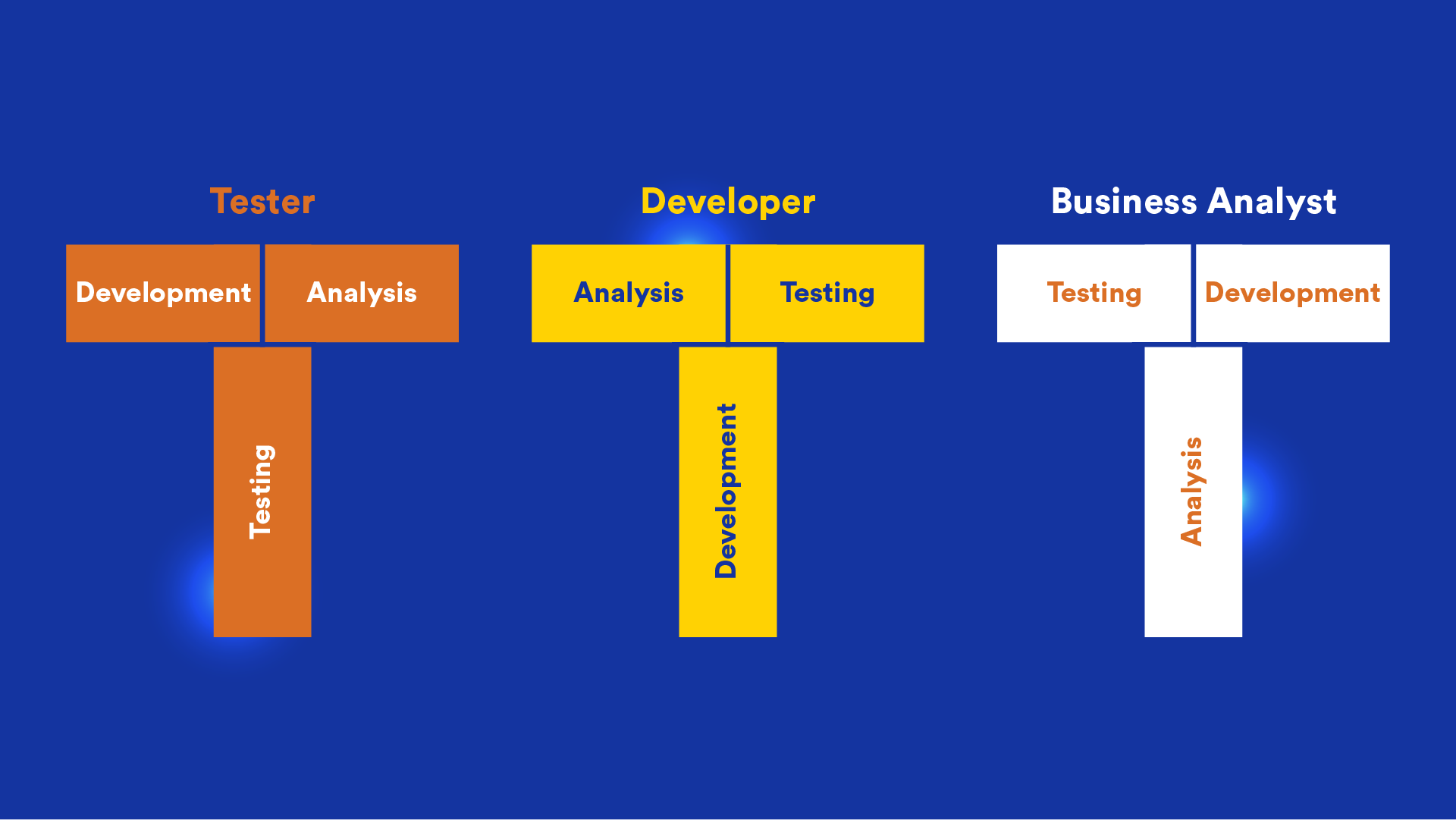Victor Munteanu, Test Lead at Levi9, started as an I-shaped employee and now defines himself as T. So did his colleague, Sorin Radu, Senior Test Developer. They both say that being a “T” places an employee in a privileged position for navigating change.
But what does a T-shape or I-shape employee exactly mean? And which type of employee are you? The letter buffet includes shapes defined by M, X, Y, or O. But you definitely don’t want to be an O!
Employee “shapes” define how domain-specific expertise, complementary knowledge, and soft skills complement each other to make you a certain type of employee. When you start your career, you are most likely an “I-shaped” employee. This means that you have deep expertise in one specific area or technology, and you are working solely within that limited frame. “This was my case as well,” says Victor. “I started as a manual tester, meaning that I had accumulated a lot of theory about testing.” Victor gradually began learning and developing new, related skills as a result of new technology and changes in the IT landscape.
Those additional skills that are just outside his domain but close enough to home make Victor a T-shaped employee. This kind of employee is defined by a broad range of skills and knowledge across different areas, together with a depth of expertise in one specific area. “The new skills you develop as a T-shaped employee are complementary. Even though they are not from your specific domain, they help you become a better professional,” says his colleague Sorin.
David Guest first introduced the concept of “T-shaped skills” or a “T-shaped person” in 1991. However, it was not until Tim Brown, the CEO of IDEO Design Consultancy, endorsed the idea when reviewing job applications that it gained significant traction. “He noticed that many applicants were focused on just one thing,” explains Victor.

He thought that finding a “T-shaped” person would help a business put together top-notch teams of people from different fields, which would make the business stronger, more effective, and maybe even more innovative.

Which “shape” are you?
Each employee type is suited for a particular role in a particular context and career stage. Some of the most common types are:
- I-shape: when you have a deep expertise in a particular area of technology.
- T-shape: with a depth of expertise in one area of technology, combined with other skills and broad knowledge.
- Π-shape: when you have two key skills, with a dash of general knowledge. The vertical line defines where you have deep, specific knowledge of a field and can function independently as a professional. The vertical line shows where you know a lot about a certain field and can work on your own as a professional. The horizontal line defines the extent of your knowledge related to your main domain — the issues where you know enough to know what to ask to gain perspective and collaborate with others.
When HR job listings describe a “collaborative person”, “team player” or “solution-oriented” person, no matter how cliche these words sound, they are looking for some overarching qualities in potential candidates for T-shaped employees.
However, the specific knowledge content of the vertical and horizontal T bars might differ depending on whether you are a tester, a developer, a system engineer, and so on.
Let’s consider an example. What skills and knowledge would a T-shaped tester have, and how would they be distributed along the vertical and horizontal bars? Victor and Sorin asked the Levi9 test community to sort and organize a set of skills along a T-shape, and here is what everyone came up with:


“The T-shape is, of course, not limited to testers”, says Sorin. This concept can be applied to other roles, such as those of developers and business analysts. However, the distribution of skills and knowledge would be different.
Why T-shaped?
The question remains, though, why should one reach out from its own expertise area to become a T-shaped worker? The biggest selling point is, according to Victor, being able to navigate change.

“By applying the T-shape model, you create opportunities for growth in other areas, and you are always available to deepen your knowledge of any subject you have started.” confirms Sorin.
Because of the agile philosophy, growing technologies, and the culture of outsourcing, people in IT have to deal with change and adapt. Working in an outsourcing company comes with frequent changes in clients, products, and technologies, requiring employees to be ready to step out of their comfort zone and develop in a new direction.
Being a T-shaped professional has many advantages, such as better communication and collaboration skills, increased interaction with other domains, autonomy, flexibility, adaptability, and increased value for the team. “It’s also less boring,” adds Victor, resonating with many. “I think you will plateau at some point if you work too much on the same project or the same technologies.”
What about the downside of being a T-shaped professional? Both Victor and Sorin see only limited disadvantages. They include being overextended, burning out, and becoming everybody’s Google — the go-to person for questions that would take a longer time to research. Time management skills and a good work-life balance can mitigate some of the downsides.
But it’s all worth it, think both Victor and Sorin, who both define themselves as T-shape testers after growing in new directions and continuously dabbling with challenges. Sorin says that “Within Levi 9, T-shape comes naturally, as we have all the facilities and guidance to develop in directions that make our testers’ lives easier.”
“At Levi9, there is a strong emphasis on the area of personal development. When we are considering our goals, we are always trying to experiment with other areas. In my opinion, this helps, especially in the current IT context, which is very, very changing. We have to evolve with the trend,” concludes Victor.



